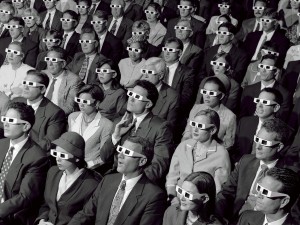The broadcast era was the period of time whereby, as our name for it suggests, broadcasting served as one of the main methods of communicating culture and ideas to a large mainstream audience. From the dominance transmission of electromagnetic signals and sounds through radio in the early 1900’s to the advent of entertainment through moving image as a household medium in television in the 1940’s, the concept of audience during the broadcast era can be understood through a “cause and effect” dynamic.
This largely revolves around the messages being broadcasted to large streams of audience and the ways in which audiences responded. As such, due to the limitations of technology for people of the time, audiences developed a reliance on broadcast media, and responded in subservience to the messages that were being broadcasted to them; they had no reason to think otherwise. This dynamic created a power shift away from audiences, and dangerously into the hands of those that were able to operate and control the media.
In the 1920’s, the media was dominated and owned by a very few wealthy people. Henry Ford, founder of the Ford Motor Company, was one of the earliest during the era to describe the power imbalance of the time stating, “people can have any colour they want, as long as it’s black.” The attitude of the wealthy elite towards the mass society was a power of being able to manipulate them to their satisfaction, the same idea for which was carried by the Nazi party through the 1930’s and 1940’s.
One of the first conceptions of the media’s influence over audience at the time was the bullet theory/hypodermic theory, which is the idea that when the media sends a message it penetrates audience and sends the message right into people. This idea was originally formed off the back of a broadcast of War of the Worlds by H.G Wells on October 30, 1938, in which an estimated 32 million people listened in terror under the false impression that the world was under attack by aliens.
Whilst the bullet theory is basic (and out-dated) in concept, the example of the War of the Worlds radio broadcast speaks volumes about the era. It exemplifies how much power media did have over audiences, as the CBS radio station responsible for the broadcast received “up to 40 percent more telephone calls than normal during the broadcast.” Furthermore, it demonstrated how dangerous a tool to audiences broadcast media was.
The advent of the television had a similar effect on audiences. Advertised as a new way for to view the world, television excited families in their own households for the first time, with moving images of people sometimes their first ever experience seeing people on a visual medium. This was a revolutionary development in culture and society in general, but it did not come without its concerns. It was a common concern of parents that their children would be exposed to violence or sexuality. Generations on from the development of the dangers bullet theory, there was also an increased awareness of the potential for governmental influence through the television medium. This was a generation slightly more aware of the technology around them in comparison with their parents.
Although in 1960, the development of a new era began with the first ever televised debate between Richard Nixon and John F. Kennedy. With a close race, those who listened on radio believed Nixon was the better candidate; better spoken and more experienced. But those who viewed the debate on television experienced something contrastingly different. Television made Kennedy look attractive, and Nixon look like a clown with shadow over his skin, ultimately swaying television viewers to believe Kennedy was the most trustworthy.
As one of the more significant moments in broadcast era history, this particular debate showcased the power of audience in the television media, as imagery proved more substantial than substance, demonstrating the vast culture shift from what had been previously been so heavily relied upon in radio. After all, how is it possible that the same text can influence two sets of audiences so differently. Marshal McLuhan, from this came to the conclusion that “the medium is the message”.
Political purposes of Government reigned supreme during this time and inevitably, the broadcast media once again proved another tool for mass manipulation. Images of the Vietnam war on television during the lateline news every night proved shocking imagery and was a key part of governmental campaign for support. However, this was occurring during a “social revolution” of sorts, with the “baby boomer” audience rejecting the political agendas being set for the first time during the broadcast era. This led Joseph Klapper to suggest that Media texts are open to interpretation by audiences.
Although the broadcast era was an period dominated by broadcast methods of communicating ideas to audiences, it was an era that developed audience expectations of the culture and society it existed, the foundations for which the contemporary relationship between audience and media would not be grounded in without.
